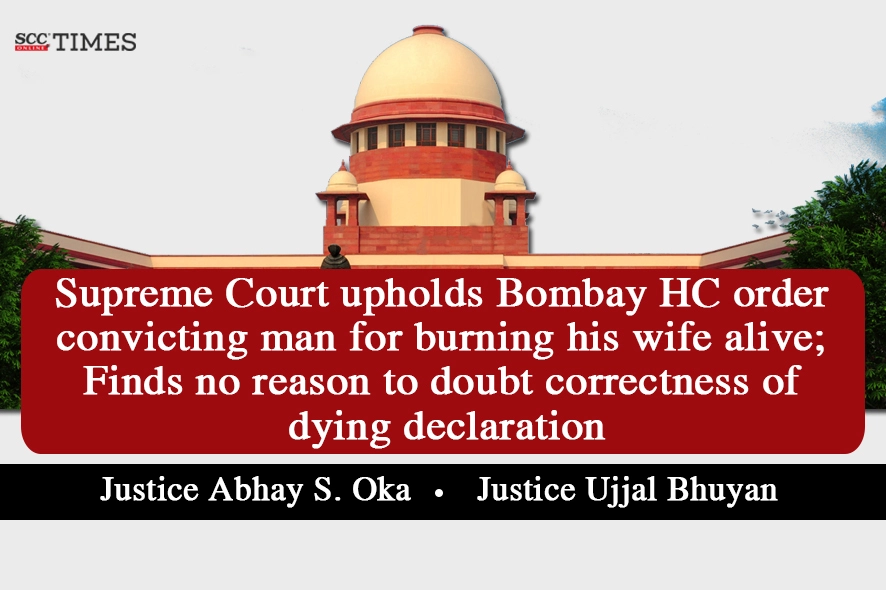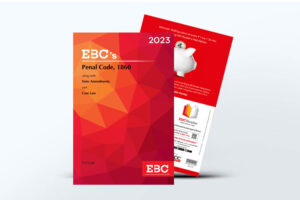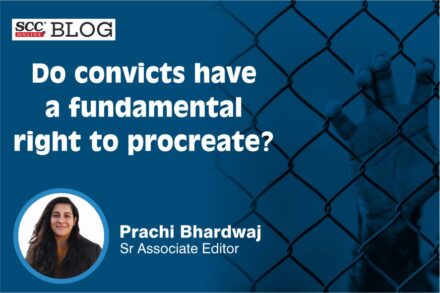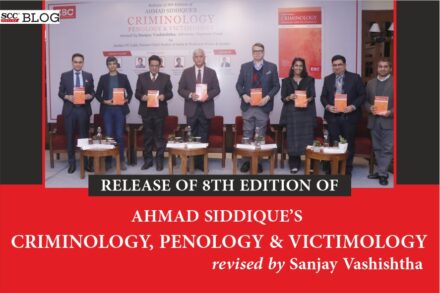Supreme Court: In a criminal appeal filed against the judgment and order passed by the Bombay High Court, wherein the Court had confirmed the conviction order passed by the Trial Court, wherein the convict was convicted for committing an offence punishable under Section 302 read with Section 34 of the Penal Code, 1860 (‘IPC’) and sentenced to suffer life imprisonment and to pay a fine of Rs. 25,000/- with a default stipulation, the Division Bench of Abhay S. Oka and Ujjal Bhuyan, JJ. has held that the convict is guilty of committing the offence and that the guilt has been proved beyond all reasonable doubt.
Background:
The wife of the convict was a police constable and lived in the police colony at Ambajogai. The convict was serving in the army. He had come home on leave. On 22-07-2002, she sustained burn injuries in the quarter where she was residing. According to the prosecution, she was subjected to cruelty by the convict and her brother-in-law. They tied her hands with a gamcha and her feet with a towel. Then the husband gagged her face. The brother-in-law got a match box and a bottle of kerosene. The husband poured the kerosene on her person and lit the matchstick. In the process, she got completely burnt. She was taken to the hospital by the neighbours where her dying declaration was recorded based on which a criminal case was registered under Sections 307, 498-A, 342, 323 and 504 read with Section 34 IPC.
On completion of investigation, a chargesheet was submitted by the police. The convict along with the father-in-law, mother-in-law and sister-in-law of the deceased were arrayed as accused. The brother-in-law was found to be a juvenile. Therefore, his case was segregated and sent to the Juvenile Justice Board.
The Trial Court concluded that prosecution could not prove that the accused persons in furtherance of their common intention had subjected the deceased to harassment and cruelty and thereby committed an offence punishable under Section 498-A IPC read with Section 34 thereof. The Trial Court also did not find any material against the father-in law, mother-in-law and sister-in-law for committing murder of the deceased. However, the Trial Court accepted the contents of both the dying declarations coupled with the evidence of the prosecution witnesses and held that death of the deceased was homicidal and not accidental. While acquitting the father-in-law, mother-in-law and sister-in-law, the Trial Court held that prosecution had established beyond reasonable doubt that the convict along with his minor brother had in furtherance of their common intention committed murder of the deceased. Therefore, the Trial Court held the convict guilty of the offence punishable under Section 302 IPC. Aggrieved by the aforesaid order of conviction and sentence, the convict preferred to appeal before the High Court. However, the High Court upheld the conviction order. Thus, the present appeal has been filed.
Analysis and Decision:
After taking note of the dying declaration, the Court noted that it clearly stated the role played by convict and the brother-in-law in the incident which led to her burn injuries. The contents of the dying declaration have been proved by the witnesses.
The Court said that though there are certain inconsistencies in their evidence, it is quite natural. Moreover, those are not material and do not affect the sub-stratum of the deceased’s statement.
The Court further noted that the incident had occurred on 22-07-2002 with the dying declaration recorded on the same day within a couple of hours whereas the evidence was tendered in court by the above witnesses after 5 years. As per the Court, such inconsistencies are bound to be there.
The Court said that identical statements by the material witnesses may create doubt about the credibility of such evidence, as being tutored. That being the position, the Court accepted the dying declaration of the deceased as a valid piece of evidence.
The Bench reiterated that once a dying declaration is found to be authentic inspiring confidence of the court, then the same can be relied upon and can be the sole basis for conviction without any corroboration. However, before accepting such a dying declaration, the court must be satisfied that it was rendered voluntarily, it is consistent and credible and that it is devoid of any tutoring. Once such a conclusion is reached, a great deal of sanctity is attached to a dying declaration and as said earlier, it can form the sole basis for conviction.
The Bench referred to Section 32(1) of the Evidence Act, 1872, and examined various judicial pronouncements governing acceptance of dying declaration.
The Court said that there is no reason to doubt the correctness of the dying declaration of the deceased which has been proved in evidence. The attending doctor certified that the deceased could narrate her statement. The substance of the dying declaration is also borne out by the medical history of the patient recorded by the doctor which has also been proved in evidence. Further, though there are inconsistencies and improvements in the version of the prosecution witnesses, there is however convergence with the core of the narration of the deceased made in the dying declaration and the medical history recorded by the doctor. Thus, the evidence on record clearly establishes the guilt of the convict beyond all reasonable doubt.
The Court noted that the convict has been on bail since 2016, thus directed him to surrender before the Trial Court within two weeks from the date of this judgment to carry out his sentence.
CASE DETAILS
|
Citation: Appellants : Respondents : |
Advocates who appeared in this case For Appellant(s): For Respondent(s): |
CORAM :









